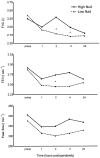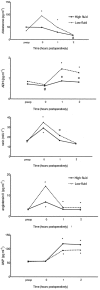Liberal versus restrictive fluid administration to improve recovery after laparoscopic cholecystectomy: a randomized, double-blind study
- PMID: 15492573
- PMCID: PMC1356497
- DOI: 10.1097/01.sla.0000143269.96649.3b
Liberal versus restrictive fluid administration to improve recovery after laparoscopic cholecystectomy: a randomized, double-blind study
Abstract
Objective: The objective of this study was to investigate the effects of 2 levels of intraoperative fluid administration on perioperative physiology and outcome after laparoscopic cholecystectomy.
Summary background data: Intraoperative fluid administration is variable as a result of limited knowledge of physiological and clinical effects of different fluid substitution regimens.
Methods: In a double-blind study, 48 ASA I-II patients undergoing laparoscopic cholecystectomy were randomized to 15 mL/kg (group 1) or 40 mL/kg (group 2) intraoperative administration of lactated Ringer's solution (LR). All other aspects of perioperative management as well as preoperative fluid status were standardized. Primary outcome parameters were assessed repeatedly for the first 24 postoperative hours and included pulmonary function (spirometry), exercise capacity (submaximal treadmill test), cardiovascular hormonal responses, balance function, pain, nausea and vomiting, recovery, and hospital stay.
Results: Intraoperative administration of 40 mL/kg compared with 15 mL/kg LR led to significant improvements in postoperative pulmonary function and exercise capacity and a reduced stress response (aldosterone, antidiuretic hormone, and angiotensin II). Nausea, general well-being, thirst, dizziness, drowsiness, fatigue, and balance function were also significantly improved, as well as significantly more patients fulfilled discharge criteria and were discharged on the day of surgery with the high-volume fluid substitution.
Conclusions: Intraoperative administration of 40 mL/kg compared with 15 mL/kg LR improves postoperative organ functions and recovery and shortens hospital stay after laparoscopic cholecystectomy.
Figures



References
-
- Holte K, Sharrock NE, Kehlet H. Pathophysiology and clinical implications of perioperative fluid excess. Br J Anaesth. 2002;89:622–632. - PubMed
-
- Lobo DN, Bostock KA, Neal KR, et al. Effect of salt and water balance on recovery of gastrointestinal function after elective colonic resection: a randomised controlled trial. Lancet. 2002;359:1812–1818. - PubMed
-
- Holte K, Kehlet H. Compensatory fluid administration for preoperative dehydration—does it improve outcome? Acta Anaesthesiol Scand. 2002;46:1089–1093. - PubMed
-
- Bisgaard T, Klarskov B, Rosenberg J, et al. Characteristics and prediction of early pain after laparoscopic cholecystectomy. Pain. 2001;90:261–269. - PubMed
-
- Marshall SI, Chung F. Discharge criteria and complications after ambulatory surgery. Anesth Analg. 1999;88:508–517. - PubMed
Publication types
MeSH terms
Substances
Grants and funding
LinkOut - more resources
Full Text Sources
Medical

